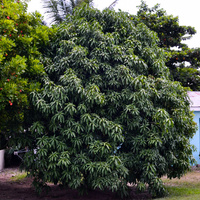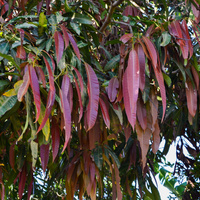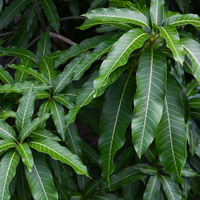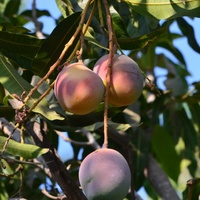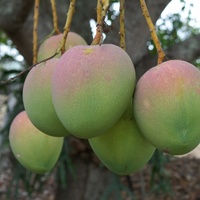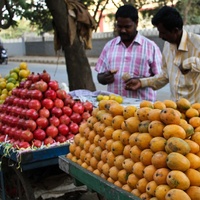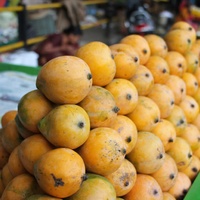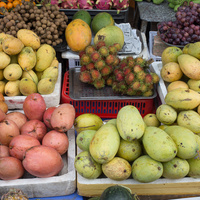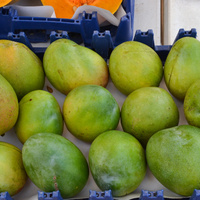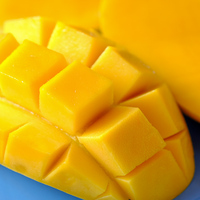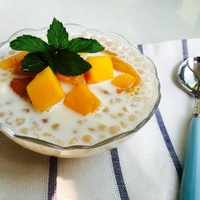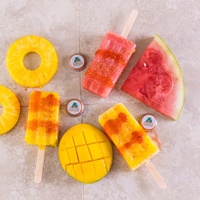Description
Mango is a well-known and widely cultivated fruit tree originating in India and Southeast Asia, its natural range extending across northeast India and neighbouring Myanmar (formerly Burma). Nowadays, as a result of its extensive cultivation, it has become naturalised in almost all, if not all, subtropical and tropical regions of the world.
Wild forms in closely spaced forests may attain a height of up to 30 m (100 ft) but are around half that height on open sites. Today's cultivated varieties are smaller still, typically 3 to 10 m (10 to 32 ft) tall, and develop a stout trunk supporting a densely leafy rounded crown.
The leaves are variable in shape and size but usually are elongated oval with a pointed tip, 10 to 20 cm (4 to 8 in) long, reddish when young, or in some varieties purple, ageing to dark glossy green. They remain on the tree throughout the year and give off a strong, sweetly resinous aroma when crushed.
The flowers are pale yellow, small and insignificant, borne in branched pyramid-shaped clusters arising at the ends of the branches. They come into bloom in the dry season, coinciding with winter in its native range and are followed by green oval fruit. The fruit ripen in summer and vary widely in shape, size and colour, depending on the variety, of which there are hundreds.
Use
Mango is cultivated for its fruit which are mostly eaten ripe, usually fresh and out-of-hand. The pulp is also pureed and made into drinks or is used to flavour desserts such as ice cream, sorbets and yoghurt, or is sometimes incorporated in cakes, puddings and other baked goods. In Mexico, the sliced pulp is enjoyed dipped in chilli flakes or powder.
Ripe but still firm fruit are sometimes processed into dried fruit, and in some regions, the unripe fruit are peeled, sliced and used to make pickles and condiments, including chutneys, acahrs and sambals. In Thailand and Vietnam, green mango pulp is sliced thinly into strands and used in salads dressed with lime juice, fish sauce and peanut oil.
Mango flowers produce good amounts of nectar and are a major bee forage and nectar source in Cuba, Haiti, Jamaica and Venezuela, with honey yields averaging around 23 kgs (50 lbs) per colony per season. The honey varies in colour from reddish to very dark amber and has a distinctive flavour.
The seed kernel contains about 10 to 15% of an edible fat known as 'Mango butter', with a melting point of 34 to 43°C (93 to 109 °F), which is similar to that of Cocoa Butter (from Theobroma cacao). This makes it valuable as a Cocoa Butter Equivalent (CBE) fat, used in extending or replacing cocoa butter in the manufacture of chocolate-based confectionery.
Mango butter also has moisturising, emollient and anti-inflammatory properties and is reportedly protective against UV (Ultraviolet) radiation. It is used in skin-care products such as lotions, sun and after-sun products, hair conditioners and as a substitute for paraffin-based emollients.
The bark on wounding exudes a reddish-brown gum that at one time was sold in bazaars in India, as a substitute for Gum Arabic (from Senegalia senegal).
Health use
Mangos are a good source of natural sugars and vitamins, in particular Beta-carotene, Vitamin A, Vitamin B1 (Thiamine), Vitamin B2 (Riboflavin) and Vitamin C (Ascorbic acid).
The gum-exude is used in dressings for scabies and cracked, dry skin, mostly on the sole of the feet.
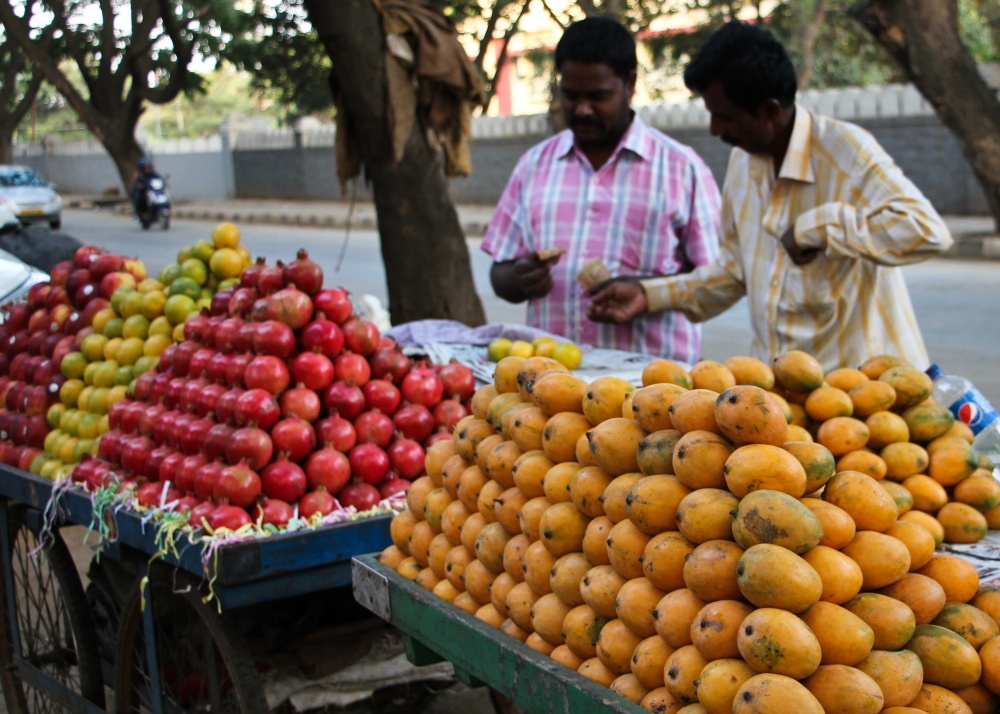
Mangoes for sale (Bangalore, India)
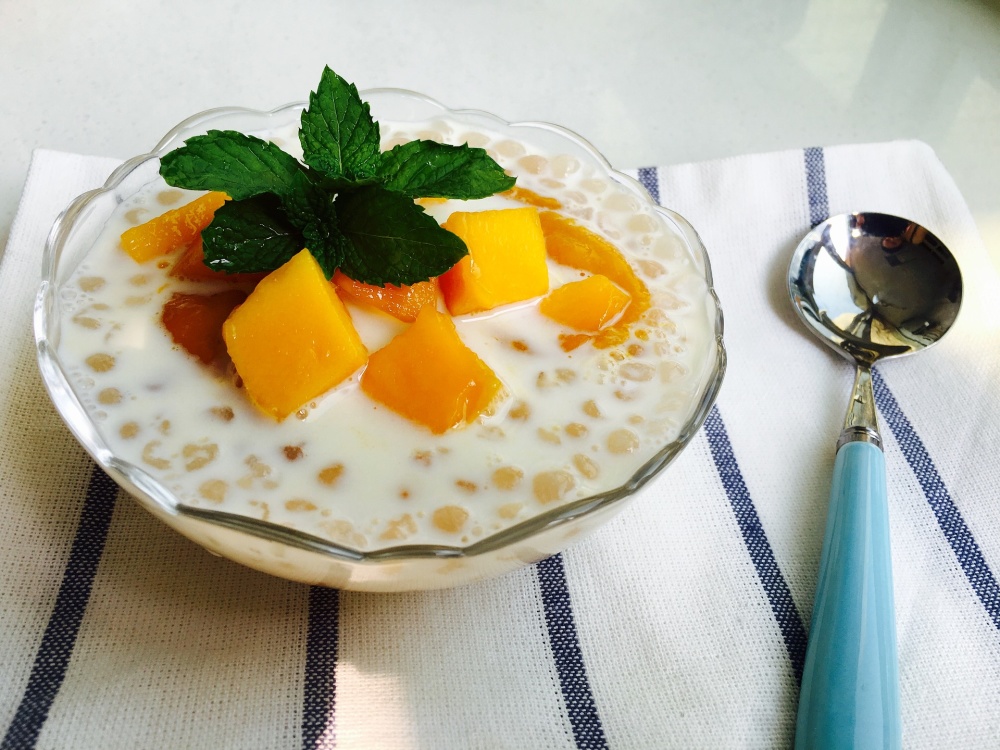
Chunks of mango with sago pudding (Image by zhaona1206 from Pixabay)
Climate
Mango flowers are susceptible to fungal attack, particularly those of commercial varieties, requiring a dry period during flowering and fruit-set to produce a good crop of quality fruit. For this reason, commercial varieties are most productive in seasonally dry climates, generally frost-free subtropical and tropical areas with annual lows of 12 to 25°C, annual highs of 22 to 35°C, annual rainfall of 700 to 5000 mm and a dry season of 3 to 8 months.
Common, non-commercial varieties are less affected by humid conditions and produce fair to good quality fruit in areas where the dry season is short or nonexistent. These include fungal (anthracnose) resistant varieties such as ‘Carabao’, 'Carrie’, ‘Earlygold’, ‘Edward’, ‘Florigon’, 'Fairchild’, ‘Paris’, 'Rapoza’, ‘Saigon’ and 'Van Dyke'.
General interest
Although normally associated with the tropics, mango cultivation has progressed in recent years to peripheral regions such as the Mediterranean, prospering in countries like Israel, Egypt, Spain and Morocco.
Growing
Mango seeds start to lose their viability after about three months and are best sown soon after the fruit has ripened.
The tree performs best on deep, rich, free-draining clay-loam, loam, sandy-loam and loamy-sand soils of a moderately acid to neutral nature, generally with a pH of 5.0 to 7.5. and on sites with full to partial sun exposure. The tree has good tolerance to drought and seasonal flooding but poor tolerance to slow-draining soils.
Mangos come in literally hundreds of varieties and cultivars, differing in tree size, fruit size, fruit shape and skin colour, as well as in the colour, flavour and texture of the pulp.
Top commercial varieties or cultivars include 'Alphonso', 'Bombay', 'East Indian', 'Florigon', 'Glen', 'Haden', 'Julie', 'Kensington Pride', 'Kent', 'Mapulehu' (aka 'Joe Welsh'), 'Osteen', 'Raspuri', 'Ricks Bowen' and 'Tommy Atkins'. 'Kensington Pride' is unusual because it comes true-to-type from seed.
Dwarf or compact varieties include ‘Fairchild’, 'Julie', 'King Thai', 'Palmer', 'Pickering', ‘Rapoza’, 'Sensation', ‘Willard’, and ‘Irwin’.
Early ripening varieties such as 'Osteen', 'Kensington Pride', 'Tommy Atkins' and 'Haden' are the most suitable for growing in cool subtropical and warm Mediterranean climates. The ‘Keitt’, variety, although grown commercially in southern California, is a late variety that ripens too late and will not flush before winter. This results in biennial bearing, meaning good cropping one year followed by poor cropping the next.
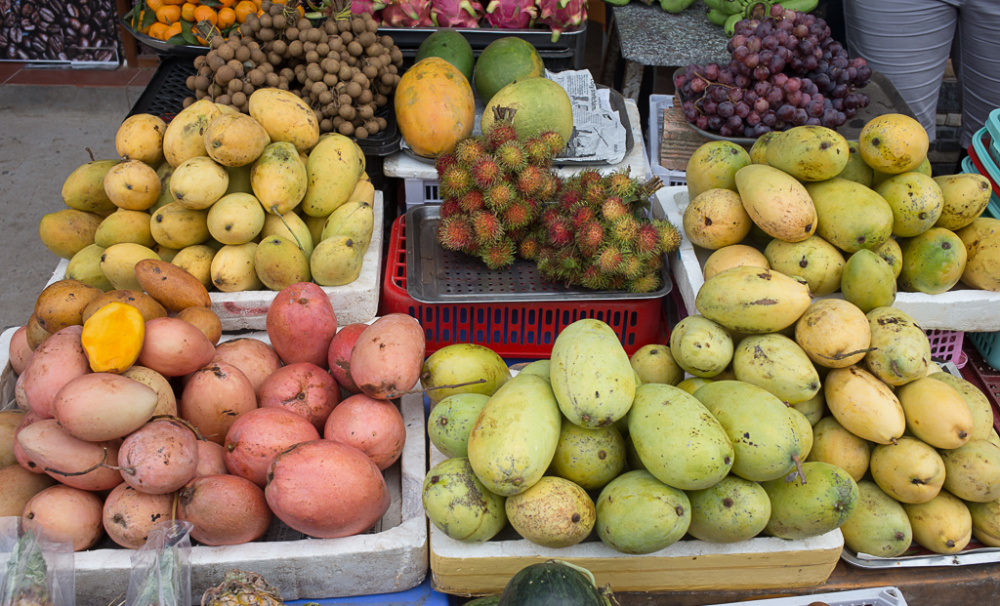
An array of mango varieties (Phu Quoc Island, Vietnam)
Problem features
Mango has naturalised in countries where it is introduced and has escaped cultivation in some, being recorded as a weed of agriculture, probably as a result of the seed being discarded by people or dispersed by large animals. It is assessed as a low weed risk species for Hawaii, by the Hawaii Pacific Weed Risk Assessment (HPWRA) project.
Where it grows
References
Books
-
Adams, C. D. 1972, Flowering plants of Jamaica, University of the West Indies, Mona, Greater Kingston
-
Bradbear, N. 2009, Bees and their role in forest livelihoods : a guide to the services provided by bees and the sustainable harvesting, processing and marketing of their products, Food and Agriculture Organization of the United Nations (FAO), Rome
-
Crane, E., Walker, P. & Day, R. 1984, Directory of important world honey sources, International Bee Research Association, London
-
Elevitch, C. R. 2006, Traditional trees of Pacific Islands: their culture, environment and use, 1st edition, Permanent Agriculture Resources, Holualoa, Hawaii
-
Fellows, P. 1997, Traditional foods : processing for profit, Intermediate Technology, Technical Centre for Agricultural and Rural Co-operation, London
-
Food and Agriculture Organization of the United Nations (FAO) 1988, Traditional food plants : a resource book for promoting the exploitation and consumption of food plants in arid, semi-arid and sub-humid lands of eastern Africa, Food and Nutrition Paper No. 42, Rome
-
Francis, J. K. 1998, Tree species for planting in forest, rural, and urban areas of Puerto Rico, U.S. Department of Agriculture, Forest Service, International Institute of Tropical Forestry, Río Piedras, Puerto Rico
-
Francis, J. K. and Liogier, H. A. 1991, Naturalized exotic tree species in Puerto Rico, General technical report SO-82, USDA Forest Service, Southern Forest Experiment Station, New Orleans
-
Francis, J. K. et al. 2000, Silvics of Native and Exotic Trees of Puerto Rico and the Caribbean Islands, Technical Report IITF-15, USDA Forest Service, Rio Piedras, Puerto Rico
-
Gilman, E. F. 1997, Trees for urban and suburban landscapes, Delmar Publishers, Albany, New York
-
Gunstone, F. D. 2011, Vegetable oils in food technology : composition, properties and uses, 2nd ed, Wiley-Blackwell, Hoboken, New Jersey
-
Hall, N. 1972, The use of trees and shrubs in the dry country of Australia, Australian Government Publishing Service, Canberra, Australian Capital Territory
-
Howes, F. N. 1949, Vegetable gums and resins, Chronica Botanica Company, Waltham, Massachusetts
-
Jensen, M. 1999, Trees commonly cultivated in Southeast Asia : an illustrated field guide, 2nd ed., Food and Agricultural Organisation of the United Nations (FAO) Regional Office for Asia and the Pacific (RAP), Bangkok
-
Krishen, P. 2006, Trees of Delhi : a field guide, Dorling Kindersley Publishers, Delhi
-
Little, E. L. & Skolmen, R. G. 1989, Common forest trees of Hawaii (native and introduced), Agricultuural Handbook No. 679, Forest Service, U.S. Department of Agriculture, Washington, D.C.
-
Luna, R. K 1996, Plantation trees, International Book Distributors, Dehradun, Uttarakhand
-
Mollison, B. 1993, The permaculture book of ferment and human nutrition, Tagari Publications, Tyalgum, New South Wales
-
Page, P. E. 1984, Tropical tree fruits for Australia, Queensland Department of Primary Industries (QLD DPI), Brisbane
-
Parrotta, J. A. 2001, Healing plants of peninsular India, CABI Publishing, Wallingford, Oxfordshire
-
Queensland Department of Primary Industries and Fisheries (QLD DPI) 2008, Queensland tropical fruit : the healthy flavours of North Queensland, Brisbane
-
Selvam, V. 2007, Trees and shrubs of the Maldives, Food and Agriculture Organisation (FAO) RAP publication (Maldives), Thammada Press Company Ltd., Bangkok
-
Sheikh M. I. 1993, Trees of Pakistan, USAID Forestry Planning and Development Project, Pictorial Printers, Islamabad
-
Shiva, M.P., 1998. Inventory of Forest Resources for Sustainable Management & Biodiversity Conservation with Lists of Multipurpose Tree Species Yielding Both Timber & Non-timber Forest Products (NTFPs), and Shrub & Herb Species of NTFP Importance, Indus Publishing Company, New Delhi
-
Wenkam, N.S. 1983 to 1990, Foods of Hawaii and the Pacific Basin (5 volumes), College of Tropical Agriculture and Human Resources, University of Hawaii, Honolulu
-
Winter, R. 2009, A consumer's dictionary of cosmetic ingredients : complete information about the harmful and desirable ingredients found in cosmetics and cosmeceuticals, 7th ed, Three Rivers Press, New York
Articles, Journals, Reports and Working Papers
-
Morton, J.F. 1964, Honeybee Plants of South Florida, Proceedings of the Florida State Horticultural Society, Vol 77:415-436.
-
Percival, S. & Findley, B. 2007 (Reviewed April 2014), What's in Your Tropical Fruit?, Fact Sheet HN 0708, University of Florida IFAS Extension Service, Gainesville, Florida
-
Skolmen R.G. 2000, Some woods of Hawaii: properties and uses of 16 commercial species, University of Hawaii, Honolulu, (Resource Managment; RM-7), 33 p.
-
Watson, B.J., & Moncur, M. 1985, Guideline criteria for determining survival, commercial and best mean minimum July temperatures for various tropical fruit in Australia (Southern Hemisphere), Department of Primary Industries Queensland (DPI QLD), Wet Tropics Regional Publication, Queensland
